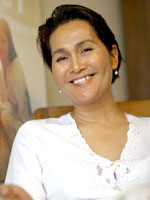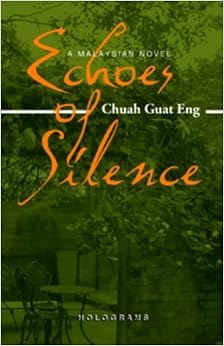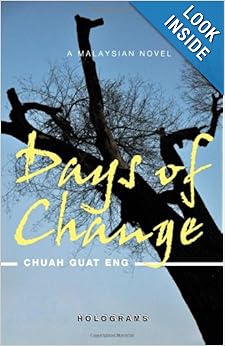1)Novel
Tash Aw (The Harmony Silk Factory)

About Tash Aw
Tash Aw was born in Taiwan to Malaysian parents and grew up in Kuala Lumpur.
He moved to England in his teens, and studied Law at the Universities of Cambridge and Warwick. He moved to London and undertook various jobs, including working as a lawyer for four years. He then studied Creative Writing at the University of East Anglia.
His first novel, The Harmony Silk Factory (2005), won the 2005 Whitbread First Novel Award, and the Commonwealth Writers Prize (South East Asia and South Pacific Region Best First Book). It juxtaposes three accounts of the life of Johnny Lim, a Chinese peasant in rural Malay. His second novel is Map of the Invisible World (2009), set in Indonesia and Malaysia in the mid-1960s.
About this novel,
The Harmony Silk
Factory (2005) made
the Man Booker Prize longlist, won a Commonwealth Writers Prize and the
Whitbread First Novel Award, making it one of the most garlanded literary
debuts since Zadie Smith shook things up with White Teeth (2000).
Its author Tash Aw was born in Taiwan and grew up in
Kuala Lumpar. In his late teens Aw moved to England to study Law at Cambridge.
After a brief career as a lawyer he took the Creative Writing MA at UEA, before
publishing a first novel which Doris Lessing described as ‘unputdownable.’
Aw is inspired by heavyweight writers such as Faulker,
Nabakov, Conrad and Flaubert, and wears those influences on his sleeve. From
Faulkner he has taken multiple narrators and non-linear narrative; from Nabakov
a delight in the possibilities of language; from Conrad an interest in the
dark, nightmarish and revelatory aspect of journeys; and from Flaubert a
heightened, intense reality generated by deliberate and sensitive use of
detail. In essence The Harmony Silk Factory is a story about
the telling of stories, although its post-modern trickery is subtle rather than
showy. It is perhaps Aw’s multiplicity of perspectives – by birth, upbringing
and education he is able to draw on experience and knowledge of three distinct
cultures – that drew him towards the kind of fiction in which a single
omniscient viewpoint is eschewed.
Set before, during and after the Japanese invasion of
British-administered Malaya in the 1940s, The Harmony Silk Factory is
the story of Johnny Lim, poor son of Chinese immigrants, who, we are told,
became a legendary textile merchant, smuggler, political activist and murderer
in the Kinta Valley. The first part of the novel is narrated by his son Jasper.
Keen to understand the truth of a father he calls a ‘liar, a cheat, a traitor
and a skirt-chaser,’ Jasper has devoted many years of his life to the pursuit
of ‘The True Story of the Infamous Chinaman called Johnny.’ From early on
Jasper reveals himself to be that most familiar of figures: the unreliable
narrator. ‘We all know the retelling of history can never be perfect,’ he says,
‘especially when the piecing together of the story has been done by a person
with as modest an intellect as myself.’ However, far from the corrupt,
womanising ‘monster’ Jasper would have us see, the Johnny we are shown is quite
different. While full of undoubted guile he is a quiet and sensitive man, the
victim of bullying British managers in the tin-mine where he works, a diligent
worker and an inspired salesman. Johnny’s brilliant gift with machines is
resented by his bosses and, after being forced out of the mine through no fault
of his own, he ends up with a new career in the Tiger Brand Trading Company,
which he is eventually to take over.
The second and third parts of the novel deal with the honeymoon
trip to the mysterious Seven Maiden Islands which Johnny takes with his
beautiful wife Snow Soong, daughter of the wealthiest man in the valley. Snow
and Johnny travel there in the company of three chaperones: Mamoru Kunichika, a
sophisticated Japanese professor, repugnant English mine-owner Frederick Honey,
and Honey’s compatriot, the effete aesthete Peter Wormwood, who sets himself up
as Johnny’s confidante. Snow, an assured and elegant woman, is not in love with
Johnny and is suspicious of, although attracted to the professor. Part two
takes the form of her diary and tells of the group’s near disastrous voyage to
the island and what takes place upon their arrival. Part three is narrated by
the elderly Wormwood who, from the overgrown garden of his old people’s home,
looks back upon his flight from England in search of a ‘tropical Arcadia’ in
the East. Wormword recalls his meeting with Johnny Lim and the others, and his
own version of what happened on the island.
Like Akira Kurosawa’s 1950 film Rashômon, The
Harmony Silk Factory deals with the near impossibility of knowing
someone, the deception of appearances, and the problematic nature of testimony.
Jasper wants us to see his father as a man of malice; Snow shows a Johnny naïve
and ineffectual; and Wormwood portrays an enigmatic figure with an enquiring
mind distinct from those around him. Their conflicting treatments tell us as
much about their own characters and prejudices as they do Johnny Lim. Who are
we to trust? Who is telling the truth? Whose version of events should we
believe?
The ambition, assurance and confidence of Aw’s debut
novel is impressive. From its formal daring – particularly the decision to use
multiple narrators – to the broad sweep of its narrative, Aw has seemingly done
anything in his power to avoid writing an autobiographical bildungsroman. Most
readers will know very little about the history of Malaysia and the fight for
control of South East Asia in the middle of the last century. In literature it
has received little attention. Most English-speaking readers will know from the
work of Anthony Burgess and his trilogy on the end of Empire. And in a sense
Aw’s book fulfils one of Hilary Mantel’s prescriptions for what makes a novel a
novel: it brings us news.
The Harmony Silk Factory is
far stronger in its truly striking opening section. Jasper Lim is a fine
creation, full of false modesty and paper-thin self-deprecation. In the second
and third parts Aw is not quite able to capture the bite, wit and energy of his
opening narrator. The Soong and Wormwood voices do not convince in the same way
and the reader cannot help but long for the return of Jasper. Nevertheless, the
gradual metamorphoses in the novel’s mood and thematic emphasis, from the dash
and impudence of Jasper’s mischievous pursuit of truth, to the regret and
emotional pain of Peter Wormword’s resigned confessional, is affecting. Aw
handles this shift in tone remarkably well. It suggests he has quite a future
ahead of him.
Garan Holcombe, 2007
Source:
http://literature.britishcouncil.org/tash-aw
2) Poetry
Shivani Sivagurunathan (Chiaruscuro)

About Shivani Sivagurunathan
Shivani Sivagurunathan is a Malaysian fiction writer and poet. Born in
Kuala Lumpur and raised in Port. Dickson, she spent eight years in the UK where
she studied Comparative Literature. Her creative work has been published in
numerous international journals including Anon, Flash and Agenda. Her poetry chapbook, Chiaroscuro, was published by bedouin
books in 2010 and her collection of short stories Wildlife on Coal Island came out in August, 2011. (Two stories
from Wildlife, "The Bat Whisperer" and "Catching Iguanas", were published in Cha.)
She is currently working on a novel set on the fictional Malaysian island, Coal
Island. She now lives in Malaysia and lectures at University of Nottingham, Malaysia.
CHIAROSCURO
by Shivani Sivagurunathanannual poetry chapbook 2010
At once delicate with essential sparse images, these poems bisect landscapes of lush vegetation with anatomies of unnamed muses. Think Lorine Niedecker’s lake in diffuse sunlight, or Wallace Stevens’ desk under a lamp’s spotlight; each itinerant poem offers details sulpted with light and shadow. Shivani Sivagurunathan gives us the contents of a poetic mulch composted in rich layering.
Excerpt 4 CORONA
A swell, a swell.
The ashes you might have left behind
when a bonfire slept in a belly on the bed,
are coming to a blood-swell,
summoning the rains
for a twisting of toes
in a garden somewhere,
to beatify one slug, two slugs,
the smooth resting place
where touch begins.
As it rises,
the air becomes big, plum-like,
ready to be scorched,
to be renewed, to be muffled in earlobes,
it can only be wonderment,
a sucking in of shadows,
a place to return to
after gallivanting through the jungle,
after reviewing the cheetah with bare hands.
Where the peak locates itself
is impossible to tell, now listen
to the bells from a noumenal land,
now stop and be silent, you will find
some chasms sitting
with big hands and space
to hold all the glories that tick and rave
in a single cell, that tick and rave
in the jaundiced light
when you and i promise
to hold this swell stiffly
until morning’s next day,
until distance cannot manage itself
between the sun and corona,
and the shine must spell itself out,
must spill itself so that i
can say nothing of love’s
certainties but only speak of the
fierce bald corona
exploding around your pupils.
Source: http://bedouinbooks.com/chiaroscuro/
3)Dramatist
Rani Moorthy (Shades of Brown)

Rani Moorthy was born in Malaysia, and came to Britain in 1996. Her previous solo show Curry Tales became the UK's most widely toured piece of Asian theatre, also broadcast on BBC Radio 4. Rasa have produced Rani's plays Pooja, Dancing Within Walls and TooClose To Home. Handful of Henna was seen at the Crucible, Sheffield and her new drama serial Whose Sari Now will be heard on BBC Radio 4 Woman's Hour in Oct. Rani has been a guest presenter for BBC1 Heaven and Earth.
About Shades of Brown
SHADES OF BROWN': UK TOUR 2 OCT - 1 DEC 2007
Written and performed by Rani Moorthy
Shades of Brown by Rani MoorthyAfter the huge success of Curry Tales, Rani Moorthy returns with a thought provoking one-woman show which tours from 2 Oct to 1 December 2007. 'Shades of Brown' sees Moorthy, with her celebrated mix of warm and powerful story telling, transforming into funny and poignant characters who share an ironic kinship through the one thing they cannot hide or hide from - their skin.
Coming out of the shadows, an albino Zulu meets superstition and prejudice head-on in a post apartheid South Africa where she is still the 'wrong' colour. On the brink of reversing her condition, an Asian scientist afflicted by vitiligo questions how brown she is prepared to go. In India an almost black bride hides her face before marriage, questioning the damage done by bleaching her skin in pursuit of beauty.
As money and time is poured into tanning or bleaching, the play explores how skin colour prejudice is more than an issue of Black/White racism. As an indicator of identity, ethnicity and status within ones own community, Rani explores the deep-rooted contradictions and trauma involved when an individual has too much or too little skin pigment. Each sympathetic and vibrant monologue portrays the pain of rejection, feelings of self-hatred and the oppression engendered when skin colour is questioned, and reveals the challenge that an individuals colour presents to there own community.
'Shades of Brown' is in part inspired by the challenges Rani faced growing up yearning for the light skin so valued by her Tamil culture. When she was five years old, her grandmother told her "You are dark skinned like me. What bad luck, you better be good at something". Almost all literature and mythology of her upbringing referred to the beauty of fair skin. From the Karma Sutra to Tantric rituals, from Hindu myths to Chinese pillow books, there was a blatant message about skin colour. Dark skinned people were never mentioned or shown as oppressed, ostracised or demonised. Living in the West for the last ten years Rani saw the irony that those with naturally light (white) skin want brown skin, while in Asia and Africa women still bleach their skin.
Whatever shade of brown you are or want to be, this new play is guaranteed to get under the skin.
Source:http://www.redhotcurry.com/entertainment/theatre/shades_brown.htm
4)Short Story
Dina Zaman (King of the Sea)

Dina Zaman is a Malaysian writer born in 1969 in Kuala Lumpur. Her book, “I am Muslim”, a compilation of column essays, published by Silverfish Books in March 2007.
Her first collection of short stories, titled, 'King of The Sea' was published by Silverfish Books in 2012. She is now working on her second non-fiction book, Holy Men, Holy Women. The work in progress is serialised in The Malaysian Insider. The book seeks and will showcase people of faiths in Malaysia.
Dina’s second book, ‘King of the Sea’, seen together with her first, provokes the same questions of the Malay-Muslim definition. Are these terms synonyms in this country? What are the lived experiences of Malay-Muslims? What are the various manifestations of this marriage?
Source: http://cambodiabookclub.com/king-of-the-sea-by-dina-zaman.html
About her short story, King of the Sea
King of the Sea
Through fiction set against a Terengganu landscape, she presents an array of Malay protagonists and their stories. Religion insinuates into their lives, although differently for each. For some it clothes like a second skin; for others it seeps in deep into the marrow. No two are alike. No two embrace their faith identically. Each confronts a different challenge.
‘Masbabu’ literally kicks off this collection of nine magical short stories. Here a nameless single Malay woman all dressed in red, driven by a ‘burly Sikh’ roars into a small kampung, assumes a rental, enlivens it with colour and music and gradually rocks the foundations of the little village. Eventually the womenfolk force her out of their community, accusing her of a litany of sins. Like getting their men to enjoy dancing, encouraging a transvestite to become a woman, setting a bad example for young girls who now want to kiss the boys.
This story, like the rest, forces readers to confront their sometimes unexamined notions of goodness and faith. Where indeed are the lines to toe? Does clothing define piety or is it merely one of its many manifestations? If a tudung is a sign of righteousness, are pretty flowers in your hair a warning of wickedness? Is it conceivable that a Muslim could desire to be an angel with feathered wings as depicted in Christian iconography? Can a people of a professed faith organise and participate in a secular celebration, like the Main Pantai Sea Festival when the imam has ‘declared it syirik, and that it was only Allah who provided the bounty from the sea, not pre-Islamic gods and demons’?
Source:
http://www.timeoutkl.com/books/articles/Synonyms-in-this-country-Dina-Zaman
5)Screenwriter
Yasmin Ahmad (Talentime)
 Date of Birth: 7 January 1958 , Bukit Treh, Muar, Johor, Malaysia
Date of Birth: 7 January 1958 , Bukit Treh, Muar, Johor, Malaysia
Date of Death: 25 July 2009 , Petaling Jaya, Malaysia (brain hemorrhage)
Mini Biography
Yasmin Ahmad was born on January 7,
1958 in Bukit Treh, Muar, Johor, Malaysia. She was a director and writer, known
for Sepet (2004), Mukhsin (2006) and Talentime (2009). She died on July 25,
2009 in Petaling Jaya, Malaysia.
Trivia
A retrospective of her first four
feature films was held at the 2006 Tokyo International Film Festival.
Her films explored romance between
members of different ethnic groups and religions, touching on the issues of
parental abandonment, AIDS and gender discrimination, against the backdrop of
Malaysia's ethnic diversity.
She started out as a copywriter.
Subsequently, she became the creative director for an ad agency. She became
known for sentimental TV ads that focused on family and religious celebrations
uniting the ethnic Chinese and Indian minorities in Malaysia with the Malay
Muslim majority.
Talentime
A high school talent competition serves as the backdrop for director Yasmin Ahmad's final feature film, a gently humorous musical comedy about a group of young students who attempt to find their footing before stepping out into the real world. Melur hails from an English\Malaysian family. Her passion is singing, and talent she sharpens by serenading her family at the breakfast table. Meanwhile Melur's chauffer, a motorbike-riding, hearing impaired student named Mahesh, ensures that the young singer reaches her rehearsals in time, and smitten guitarist Hafiz pines for Melur from afar while tending to his ailing mother. ~ Jason Buchanan, Rovi






